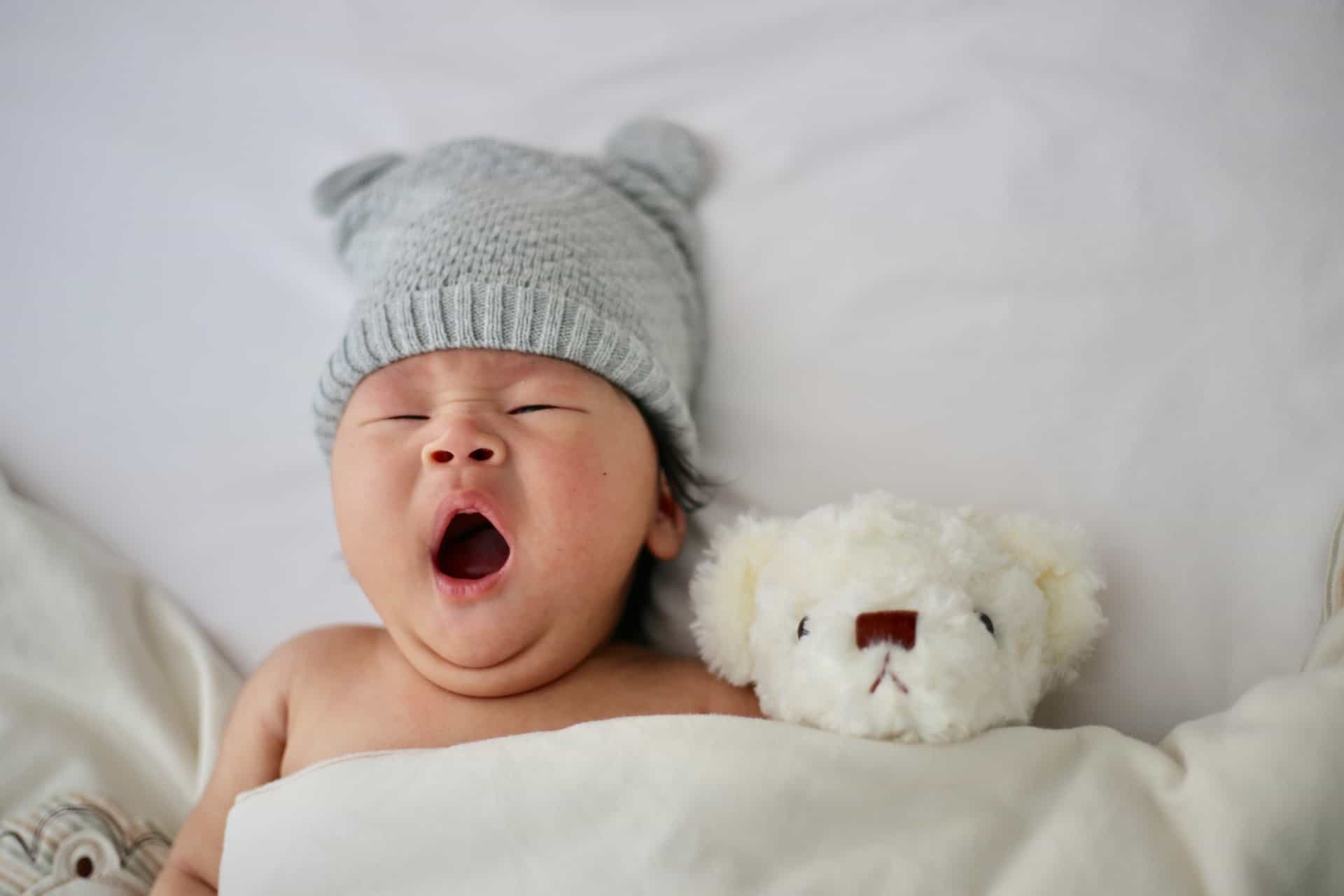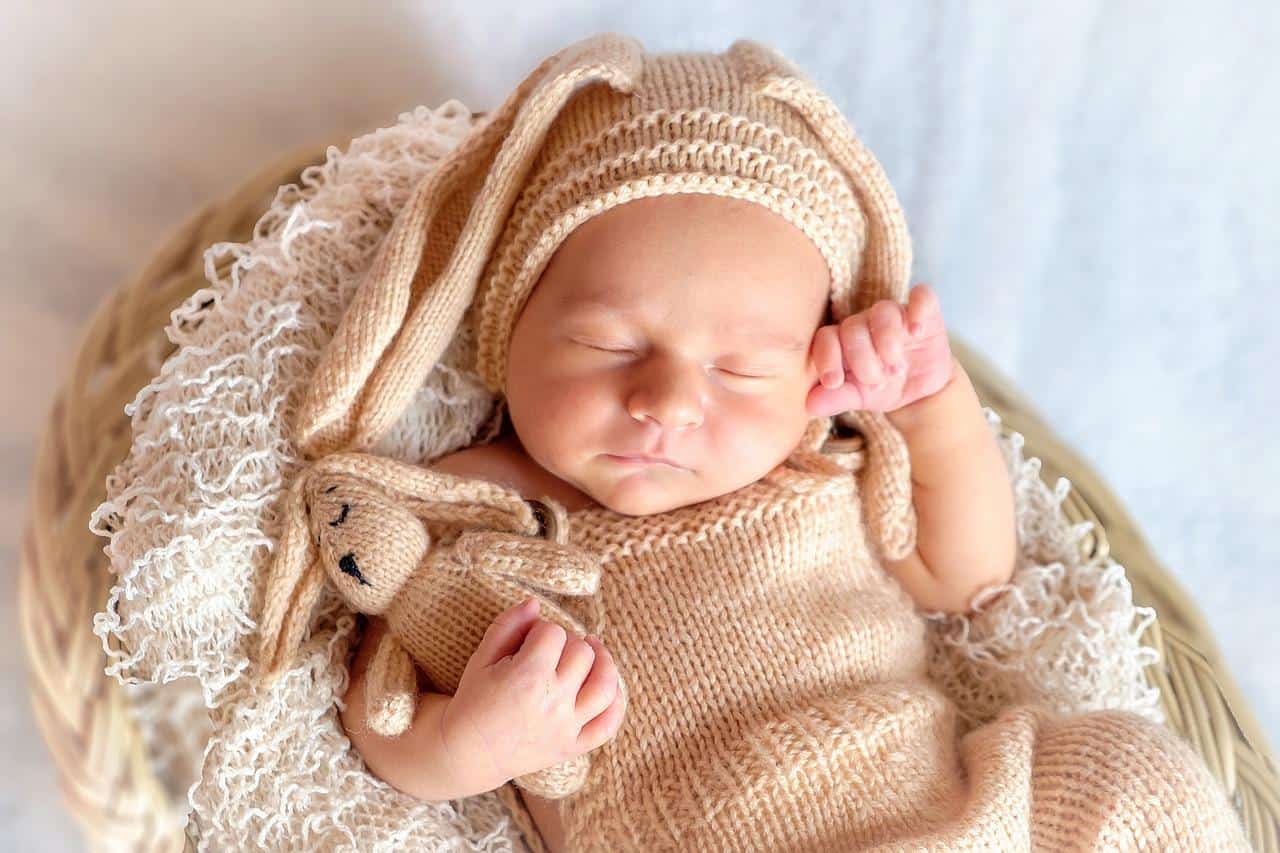You may be wondering, when can baby sleep with a lovey? Since babies are at risk for SIDS there are guidelines we as parents are highly encouraged to follow. These guidelines are in the best interest of our babies’ health and safety. As a Registered Nurse, Certified Pediatric Sleep Consultant, and mama of two, I have education in all areas of healthy sleep habits, sleep training techniques, safe sleep practices, and of course tips and tricks to aid in the sleep department.
I am here to communicate how the use of a lovey can positively impact sleep, see when can a baby sleep with lovey, and also make sure to educate you on the importance of maintaining safe sleep guidelines.
The bottom line: a baby can sleep with a lovey anytime after 12 months of age. The reason to wait until after 12 months is due to safety. Placing items in our infant’s sleep space before the 12-month mark increases the risk of SIDS and this is why it is highly recommended to wait to introduce a lovey once your baby has hit the one-year mark. You can present a lovey to your baby prior to the one year mark during playtime but refrain from leaving the lovey in their sleep space.
What Is a Lovey?
A lovey is a small item such as a security blanket or soft animal with attached fabric making this part of the “blanket”. This item can provide comfort and security to your little one. Introducing a lovey can help improve your little one’s ability to soothe and settle themselves back to sleep. This is due to the fact the lovey can be the comforting item they use in the middle of the night to help them fall back asleep.
One particular item you might not have considered as a lovey would be your baby’s pacifier, if your baby uses a pacifier they may have already grown attached to this item. Offering a pacifier in your baby’s sleep space is the only safe item allowed in the crib before the 12-month mark. Pacifiers can greatly reduce the risk of SIDS but it is important to note that pacifier clips are not safe within their sleep space and should be avoided.
When you do pick out an item to introduce as a lovey to your baby, you want to make sure it is safe as possible. Therefore we want to avoid items with small pieces such as buttons or eyes on stuffed animals, in addition to avoiding any attached strings/ribbons. You want to look for a lovey that is ideally soft, small, and has no removable pieces or parts.
Safe Sleep Guidelines
The American Academy of Pediatrics (AAP) has a set of guidelines to follow to keep your baby safe. These guidelines discuss the importance of not having items within your baby’s sleep space, as they can pose risk and increase the risk of injury or death.
Let us review these safe sleep guidelines so we have a better understanding of introducing a lovey. The best way to remember safe sleep guidelines is to follow the ABCs.
A: Alone – Bed-sharing increases the risk factor of SIDS.
B: Back – Placing your baby on their back is the safest position for sleep and reduces the risk of SIDS.
C: Crib – No items within their sleep space; no pillows, blankets, stuffed animals, or people.
As much as you may want to introduce a lovey to your baby earlier than the 12-month mark, your baby’s safety is more important. In due time they can sleep with a lovey and you will have peace of mind knowing you incorporated one when it was safest to do so.
How to Introduce a Lovey
You can introduce a lovey to your baby before the 12-month mark but you want to avoid leaving the item within their sleep space. As a sleep expert, I encourage my clients to present a lovey to their babies before 12 months of age. When we introduce a lovey to our baby, over time they can create a connection and bond with this particular item.
The best way to introduce a lovey is to present it to them during feedings. Whether the baby is breastfeeding or bottle feeding, whoever is feeding the baby can have the lovey between them. The most important feed to involve a lovey’s presence is during the bedtime feed. This can help with the security of the particular item.
When having a contact nap on dad or mom, this is also a time you can have a lovey next to your baby. It is always important to note this should be when you are awake and supervising the baby sleeping on you.
It is also great practice to introduce a lovey during daytime play, it is especially helpful when your little one is playing in their sleep space during their wake time supervised by a parent.
When we incorporate the lovey into our sleep routines, it can act as a sleep signal. This process would involve having the lovey as part of the nap prep or bedtime routine.
Ideas can include letting your baby hold onto the lovey when you are doing their diaper change before putting pj’s on or during the book and cuddle session before you put them down in their sleep space.
Over time your baby will develop an attachment and bond to their particular lovey item. When the time comes and your baby has hit the one-year mark, you can allow the lovey into their sleep space.
The more the lovey smells like mom and dad, the better it can help create security for that particular item. As the parent, spend a night sleeping with your baby’s lovey before introducing it to them. Your baby will pick up on the familiar scent.
FAQ – When Can a Baby Sleep with Lovey?
Question: Is a lovey safe for a baby?
Answer: A lovey is a security item that is safe to use after the 12-month mark. Due to infants’ risk of SIDS, it is important to follow AAP guidelines in the first year of life and this notes no items (including lovies) within your baby’s sleep space. When picking a lovey to introduce to your baby, make sure it has no buttons/eyes, strings/bows, or removable pieces.
Question: Do babies need a lovey?
Answer: Babies go through their entire first year without having a lovey while sleeping, once they have hit 12 months it is safe to introduce a lovey. Having a lovey can help with security and attachment to the particular item, positively impacting your child’s ability to sleep more soundly. Baby can grow attached to a lovey if presented to them in the first year of life, and you may find your toddler sleeps best when the lovey is available to them. Introducing a lovey is not mandatory but you may find it very helpful.
Question: Can a 6-month-old sleep with a lovey?
Answer: A 6-month-old should not be provided with a lovey due to the potential risks associated with suffocation. Having a lovey within your baby’s sleep space before the 12-month mark can increase their risk of SIDS. Once your baby has reached their first birthday you can allow them to sleep with their lovey.
Final Thoughts
When a baby creates a bond to a security item such as a lovey, it can positively impact their sleep. During the middle of the night wakings or early morning rising, your child will have a higher probability of sleeping more soundly with their beloved item. Toddlers go through episodes of separation anxiety and having a lovey as their security item can help them through these developmental transitions.
Some children enjoy the sensory opportunity a lovey provides. Expert tip: have a backup lovey the same as the one you have presented to your child. If a lovey ever goes missing it can make the process of falling asleep more difficult if they are attached to their comfort item. Always keep a spare lovey somewhere safe in your home as a backup or alternative, trust me on this.
Kayla is a mama of two littles, each born during the Covid-19 pandemic. Prior to becoming a mom, she worked as a Registered Nurse for 12 years. Now as a Certified Pediatric Sleep Consultant, she owns and runs Serenity Sleep Consulting full time.
After having her first baby, sleep deprivation hit hard. She was desperate for rest and knew she needed to focus on establishing a healthy sleep foundation. Kayla researched infant sleep and started to focus on what she likes to call Sleep Shaping. Her son went from waking every hour to sleeping 4-5 hour stretch, followed by 6-8 hours, and eventually 12 hours at 3 months of age. This method has turned into her signature service, it allows her to provide education and tools to help families with newborns. She also works with those who have babies 4 months upwards of 4-5 years.
We all function at our optimal level with a full night’s rest and Kayla loves to support parents in this journey!



